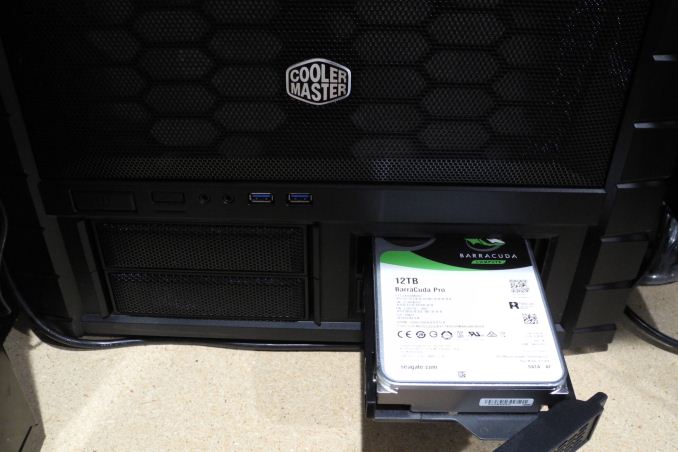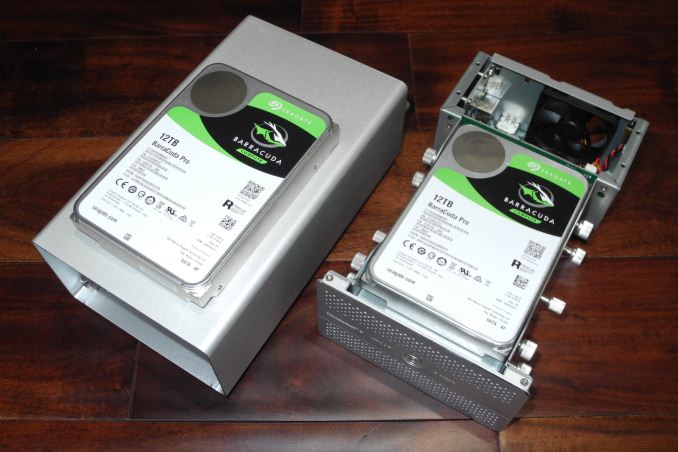Seagate BarraCuda Pro 12TB HDD Review
by Ganesh T S on November 15, 2017 8:00 AM EST- Posted in
- Storage
- Seagate
- HDDs
- Helium HDD
Concluding Remarks
The BarraCuda Pro 12TB is a unique product in the market. It is not often that we see a leading capacity 'desktop-class' hard drive rated for 24x7 operation or workload ratings of 300TB/year. To top it all, Seagate is even throwing in a 5-year warranty. A 2-year data recovery service (DRS) is also included. The lower load/unload cycles rating (300K, compared to the 600K in the equivalent NAS drives) and MTBF (1M hours, compared to 1.2M for the equivalent Pro NAS drive) are slightly disappointing aspects, but, they are more than made up for by the warranty and DRS.
In the gaming desktops market in particular, we are seeing per-game storage requirements running into 100s of GBs, and SSDs continuing to remain above $0.33/GB. Under these circumstances, high-capacity hard drives are bound to become relevant again. In our evaluation, the drive managed to perform quite well for largely sequential workloads (typical of bulk storage requirements in gaming workloads).
Consumers dealing with content creation can also use the BarraCuda Pro as part of a direct-attached storage system. For single-user scenarios, a DAS inherently makes more sense than a NAS. It allows use of enclosures sporting interfaces with higher speeds. The BarraCuda Pro 12TB drive shows great performance in such devices.
In our evaluation, the drive successfully met all of Seagate's claims. Helium drives have achieved economies of scale and are now mass-market devices. The current street price of the BarraCuda Pro 12TB ($500) is already lower than the suggested launch price ($530). The other 12TB Seagate options are the IronWolf NAS drive at $450, IronWolf Pro at $510, and the Enterprise Capacity at $469. We also have the Western Digital WD Gold at $522. The IronWolf has a lower workload rating (180 TB/yr vs 300 TB/yr) and also doesn't have the data recovery service available with the BarraCuda Pro and the IronWolf Pro. None of the enterprise drives carry the DRS option, which justifies the premium associated with the two Seagate Pro drives.
Pricing the BarraCuda Pro mid-point between the IronWolf and the IronWolf Pro would have made it an obvious choice for a high-capacity desktop / DAS usage drive. As it currently stands, it is difficult to choose between the IronWolf Pro and the BarraCuda Pro, as only $10 separates them. The IronWolf Pro also has a higher load/unload cycle rating. Seagate claims that the firmware in the BarraCuda Pro is tuned specifically for typical high-end desktop workloads. However, it is unlikely that consumers will see obvious performance differences between the two drives in typical single-user scenarios. In the end, the DRS ensures that customers are unlikely to go wrong with either the IronWolf Pro or the BarraCuda Pro, irrespective of the end application.












62 Comments
View All Comments
phoenix_rizzen - Wednesday, November 15, 2017 - link
Go read through some of the quarterly drive reports from Backblaze. The larger sized Seagates are much more reliable than the earlier 1-3 TB drives. Although Toshiba and Hitachi are still the drives to beat for reliability.artk2219 - Wednesday, November 15, 2017 - link
Hey Ganesh, thank you for the review, honestly i'm always surprised by how much faster hard drives are now than they were even 5 years ago. On an unrelated question, how do you like that cooler master case? I've been considering getting one recently for its openness but I wasn't sure about whether or not i could get used to how much horizontal space it takes up on a desk.ganeshts - Wednesday, November 15, 2017 - link
I simply love it, but, I have to let you know that my requirements are not the typical computer builder's requirements.I wanted something that could be used to easily hot-swap hard drives (since I tend to benchmark internal drives quite a bit) - the two front bays serve this purpose well.
I wanted it to be fairly portable - the 'carry handles' on either side have been put to use many times and have worked well.
There is plenty of ventilation, but, to be honest, I am not overclocking, and I don't even have a dGPU in that build. So, I really can't comment on that aspect.
Lastly, I wanted a LAN box rather than a tower because I wanted all the ports to be easily accessible when placed in makeshift 'rackmount' environments. Currently I have it in a repurposed garage shelving unit [ https://www.walmart.com/ip/Edsal-36-W-x-18-D-x-72-... ].
artk2219 - Wednesday, November 15, 2017 - link
Minus the moving those were also my considerations. I'm constantly swapping and playing with different GPU's and CPU's so the ability to just open the top and be there is a big plus. I tend to not keep the exact same config for too much time, and in the time ive had my current corsair carbide 500r, ive gone through 2 motherboards, 4 different cpu's, 5 GPU's, and multiple hard drives. Not to mention all of the parts i've just tested to verify that it works for family and friends. Normally I keep cases for 5 to 7 years or until they've just had enough, but since I saw this case it seemed like it would be perfect for the sort of use I have in mind, especially now that AM4 seems like it'll have quite a few options available to it like AM2+ and AM3+ did, and I'm building up an AM4 build with an Athlon x4 950. I honestly haven't found a good review of one, and its cheap enough for me to just get one to play with while I see whether or not i want to spring for a 1600, 1700, or just wait for the refresh, although it is slower than my FX 8320 @4.4. Thanks for the information though!Liltorp - Thursday, November 16, 2017 - link
All my important data (around 75GByte) I have in 4 copies. One copy on my personal PC, one copy on my home NAS hidden away, one copy in Google Drive and one copy on an external harddisk that I keep at my workplace. Location redundance is important.My less-imprortant data (around 5TByte mainly video material) I have in 2 copy. One copy on my personal PC and one copy on my home NAS.
chrysrobyn - Thursday, November 16, 2017 - link
I find these types of benchmarks far less interesting than the SSD benchmarks Anandtech uses. I know spinners would get blown out of the water by the top end SSDs on The Destroyer, but I do wonder how the fastest spinners would compete with the lowest end SSDs. Spinning media has its place in this world, and I'd really like to see benchmarks that tell that story.b1gtuna - Thursday, November 16, 2017 - link
Would anyone use this without redundancy? It is nice that they throw in 2 years of data recovery as part of the warranty, but I am genuinely curious if the drive technology has matured enough to guarantee safety from data loss.jameskatt - Sunday, November 19, 2017 - link
I hope one of these days 12 TB drives are < $100.Beaver M. - Sunday, November 19, 2017 - link
They would be in a few years. But not with this oligopoly. Even 8 TB ones are still extremely expensive, and those are over 3 years old now.stevenrix - Tuesday, November 21, 2017 - link
Seagate drives? Thanks but no thanks.